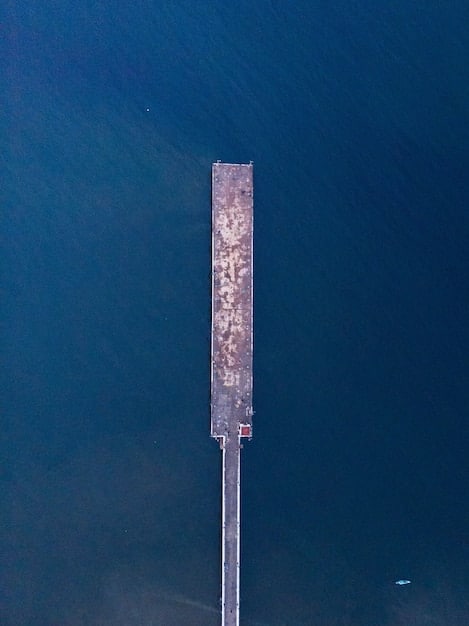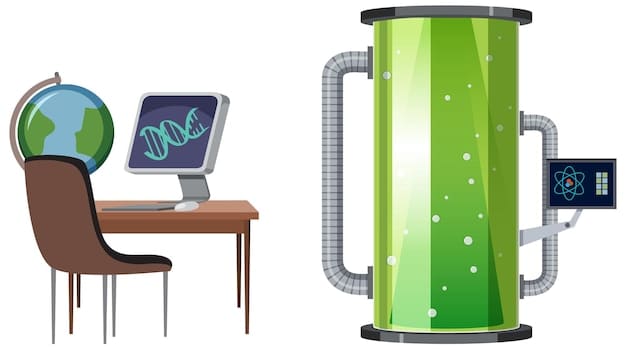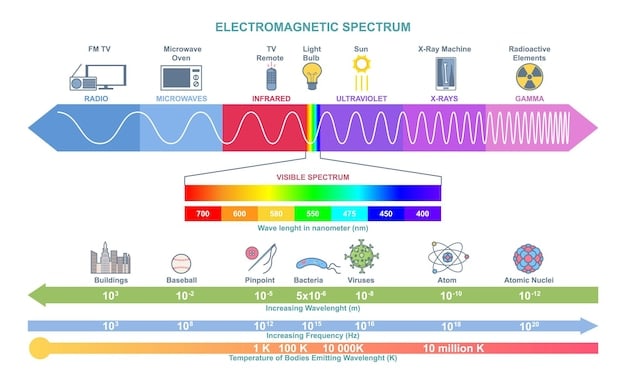Wave Energy: Powering the US Coastline Beyond Solar Panels by 2030

Wave energy technologies are emerging as a promising alternative to solar panels for powering the US coastline, leveraging the ocean’s potential to provide clean, sustainable energy by 2030 through innovative devices like oscillating water columns and wave energy converters.
As the world seeks sustainable energy solutions, the focus is shifting **beyond solar panels** to harness the immense potential of the ocean. **Exploring the emerging wave energy technologies poised to power the US coastline by 2030** reveals a promising path toward clean, renewable energy, leveraging the constant motion of the waves to generate electricity.
Unlocking the Ocean’s Potential: A Wave of Change for US Energy
The United States boasts a vast coastline, making it an ideal location for harnessing wave energy. This renewable resource could significantly reduce our reliance on fossil fuels and contribute to a cleaner, more sustainable energy future. Wave energy technologies are rapidly advancing, promising a viable alternative or complement to traditional solar power.
The Promise of Wave Energy
Wave energy offers several advantages over other renewable sources. It is more predictable than solar or wind, providing a consistent and reliable energy supply. Additionally, the energy density of waves is significantly higher than that of solar or wind, meaning that wave energy converters can generate a substantial amount of power in a relatively small area.
Challenges and Opportunities
Despite its potential, wave energy faces challenges. The harsh marine environment can be tough on equipment, requiring robust and durable designs. Additionally, the cost of deploying and maintaining wave energy converters can be high. However, ongoing research and development are addressing these challenges, making wave energy an increasingly attractive option.
- Predictability: Wave patterns are generally more predictable than solar or wind, enabling better grid integration.
- Energy Density: Waves pack a higher energy punch than solar or wind, requiring less space for comparable power generation.
- Reduced Visual Impact: Some wave energy devices can be submerged, lessening the visual impact on coastal landscapes.
- Economic Growth: Developing wave energy technologies can create new jobs and stimulate economic growth in coastal communities.
In conclusion, wave energy holds immense promise for transforming the US energy landscape, offering a sustainable and reliable alternative to fossil fuels and even supplementing solar power. Overcoming the existing challenges through continuous development and strategic investment will pave the way for a wave-powered future.

Oscillating Water Columns: Capturing the Breath of the Ocean
One of the most promising wave energy technologies is the Oscillating Water Column (OWC). These devices mimic the action of a piston, using the rising and falling motion of waves to compress air and drive a turbine. OWCs can be built on shore or offshore, making them adaptable to various coastal environments.
How Oscillating Water Columns Work
An OWC consists of a partially submerged structure with an opening to the ocean. As waves enter the chamber, they cause the water level inside to rise and fall, compressing and decompressing the air above. This compressed air is then forced through a turbine, generating electricity. The turbine is typically designed to rotate in the same direction regardless of the airflow direction, ensuring continuous power generation.
Advantages of Oscillating Water Columns
OWCs offer several advantages, including their relatively simple design and their ability to be integrated into existing coastal structures. They also have minimal environmental impact, as they do not require any moving parts in the water. Furthermore, OWCs can provide coastal protection by acting as breakwaters, reducing erosion and storm surge.
- Simple Design: OWCs have a straightforward design with few moving parts, reducing maintenance and increasing reliability.
- Coastal Integration: They can be integrated into existing breakwaters or harbor walls, minimizing visual impact and maximizing space utilization.
- Environmental Benefits: OWCs can act as artificial reefs, providing habitat for marine life and promoting biodiversity.
Oscillating Water Columns represent a vital step towards harnessing wave energy, providing a sustainable and environmentally friendly energy source. Their versatility and potential for integration into coastal infrastructure make them a promising technology for powering coastal communities and contributing to a cleaner energy future.
Wave Energy Converters: Floating Powerhouses of the Sea
Wave Energy Converters (WECs) encompass a diverse range of devices designed to capture the energy of ocean waves and convert it into electricity. Unlike OWCs, WECs often involve floating structures that move with the waves, directly harnessing their kinetic energy. These devices come in various forms, each suited to different wave conditions and coastal environments.
Types of Wave Energy Converters
There are several types of WECs, including point absorbers, attenuators, and terminators. Point absorbers are floating devices that move up and down with the waves, using this motion to drive a generator. Attenuators are long, floating structures that flex as waves pass along their length, generating electricity through hydraulic systems. Terminators are devices that capture waves as they approach the shore, converting their energy into electricity.
Advantages of Wave Energy Converters
WECs offer high energy conversion efficiency and are capable of generating significant amounts of power. They can be deployed in deep water, where wave energy is more consistent and abundant. Additionally, WECs can be designed to minimize environmental impact, with some devices even providing habitat for marine life.

In conclusion, Wave Energy Converters stand as innovative solutions for tapping into the vast energy reserves of the ocean. Their capacity for high energy conversion, coupled with their potential to minimize environmental effects, positions them as significant contributors to a sustainable energy future, particularly for coastal regions.
The Role of Infrastructure and Grid Integration
The successful deployment of wave energy technologies relies heavily on the development of robust infrastructure and efficient grid integration. Connecting wave energy converters to the existing power grid requires careful planning and investment in transmission lines and substations. Additionally, adequate port facilities and maintenance infrastructure are essential for ensuring the long-term reliability of wave energy installations.
Connecting to the Grid
Integrating wave energy into the grid presents unique challenges due to the variability of wave patterns and the intermittent nature of power generation. Advanced control systems and energy storage technologies are needed to smooth out the fluctuating power output and ensure a stable supply. Smart grids, which can dynamically manage energy flow, are crucial for accommodating wave energy and other renewable sources.
Developing Port Infrastructure
Developing wave energy projects requires specialized port facilities for the construction, deployment, and maintenance of wave energy converters. These ports must be equipped with heavy-lift cranes, deep-water access, and ample storage space. Additionally, skilled technicians and engineers are needed to operate and maintain the wave energy installations.
Wave energy integration is paramount for maximizing the potential of this renewable resource. Investing in smart grids and advanced energy storage technologies will pave the way for wave energy to become a reliable and valuable component of the energy mix, promoting a cleaner and more resilient energy system.
Economic and Environmental Impact: A Sustainable Future
Harnessing wave energy has significant economic and environmental implications. The development of wave energy technologies can create new jobs in manufacturing, construction, and maintenance, stimulating economic growth in coastal communities. Environmentally, wave energy offers a clean alternative to fossil fuels, reducing greenhouse gas emissions and mitigating climate change.
Economic Benefits
Investing in wave energy can create a ripple effect throughout the economy. Local businesses can benefit from increased demand for goods and services, while coastal communities can attract tourists and investors. Additionally, wave energy can reduce reliance on imported fuels, improving energy security and reducing trade deficits.
Environmental Advantages
Wave energy is a carbon-neutral energy source, producing no greenhouse gas emissions during operation. It can also reduce air and water pollution, improving public health and protecting ecosystems. Furthermore, wave energy can help conserve freshwater resources, as it does not require any water for power generation.
- Job Creation: Wave energy projects create jobs in manufacturing, construction, maintenance, and research.
- Reduced Emissions: Wave energy reduces greenhouse gas emissions and air pollution, contributing to a healthier environment.
- Energy Independence: Wave energy reduces reliance on imported fuels, improving energy security and reducing trade deficits.
- Coastal Resilience: Wave energy devices can provide coastal protection, reducing erosion and storm surge.
Wave energy’s economic and environmental impacts make it a compelling choice for a sustainable energy future. By investing in this renewable resource, the US can achieve significant economic benefits, reduce environmental harm, and enhance coastal resilience, paving the way for a more prosperous and sustainable future.
Future Outlook: Wave Energy by 2030 and Beyond
The future of wave energy is bright, with ongoing research and development driving innovation and reducing costs. By 2030, wave energy technologies are expected to become increasingly competitive with other renewable sources, playing a significant role in the US energy mix. Continued investment and policy support will be critical to realizing the full potential of wave energy.
Technological Advancements
Ongoing research is focused on improving the efficiency, reliability, and durability of wave energy converters. Advanced materials, innovative designs, and smart control systems are being developed to optimize performance and reduce maintenance costs. Additionally, researchers are exploring new ways to integrate wave energy with other renewable sources, such as solar and wind.
Policy and Investment
Government policies that support wave energy development, such as tax incentives, grants, and loan guarantees, can accelerate deployment and attract private investment. Streamlined permitting processes and clear regulatory frameworks are also essential for creating a favorable environment for wave energy projects. Furthermore, public-private partnerships can leverage the expertise and resources of both sectors to drive innovation and commercialization.
In conclusion, Wave energy is poised to transform the US energy system, offering a clean, reliable, and sustainable source of power. With continued technological advancements, policy backing, and strategic investments, wave energy will power the US coastline by 2030 and far beyond, making significant contributions to a cleaner, more resilient energy future.
| Key Point | Brief Description |
|---|---|
| 🌊 Wave Energy Potential | Harnesses ocean waves for clean, renewable power. |
| 🔄 OWC Technology | Uses oscillating water columns to drive turbines. |
| ⚡ WEC Devices | Converts wave motion into electricity through various designs. |
| 🌱 Sustainable Impact | Reduces emissions and boosts coastal economies. |
Frequently Asked Questions (FAQ)
▼
Wave energy is a form of renewable energy derived from the motion of ocean waves. It works by converting the kinetic energy of the waves into electrical energy using various technologies like Oscillating Water Columns (OWCs) or Wave Energy Converters (WECs).
▼
Wave energy is more predictable and has a higher energy density than solar power. Waves are generally more consistent than sunlight, and wave energy devices can generate more power in a smaller area compared to solar panels.
▼
Wave energy technologies are generally considered environmentally friendly, producing no greenhouse gas emissions during operation. Some devices can even provide habitat for marine life and reduce coastal erosion.
▼
Wave energy technologies are rapidly advancing, with several pilot projects underway in the US. Experts anticipate that by 2030, wave energy will play a more significant role in powering coastal communities.
▼
Wave energy faces challenges related to cost, durability, and grid integration. The harsh marine environment can be tough on equipment, and integrating wave energy into the grid requires advanced control systems and energy storage technologies.
Conclusion
In summary, the exploration of wave energy technologies represents a significant leap towards diversifying the US energy portfolio. With ongoing advancements and strategic investment, wave energy promises to be a key player in powering the US coastline, offering a sustainable path forward.





